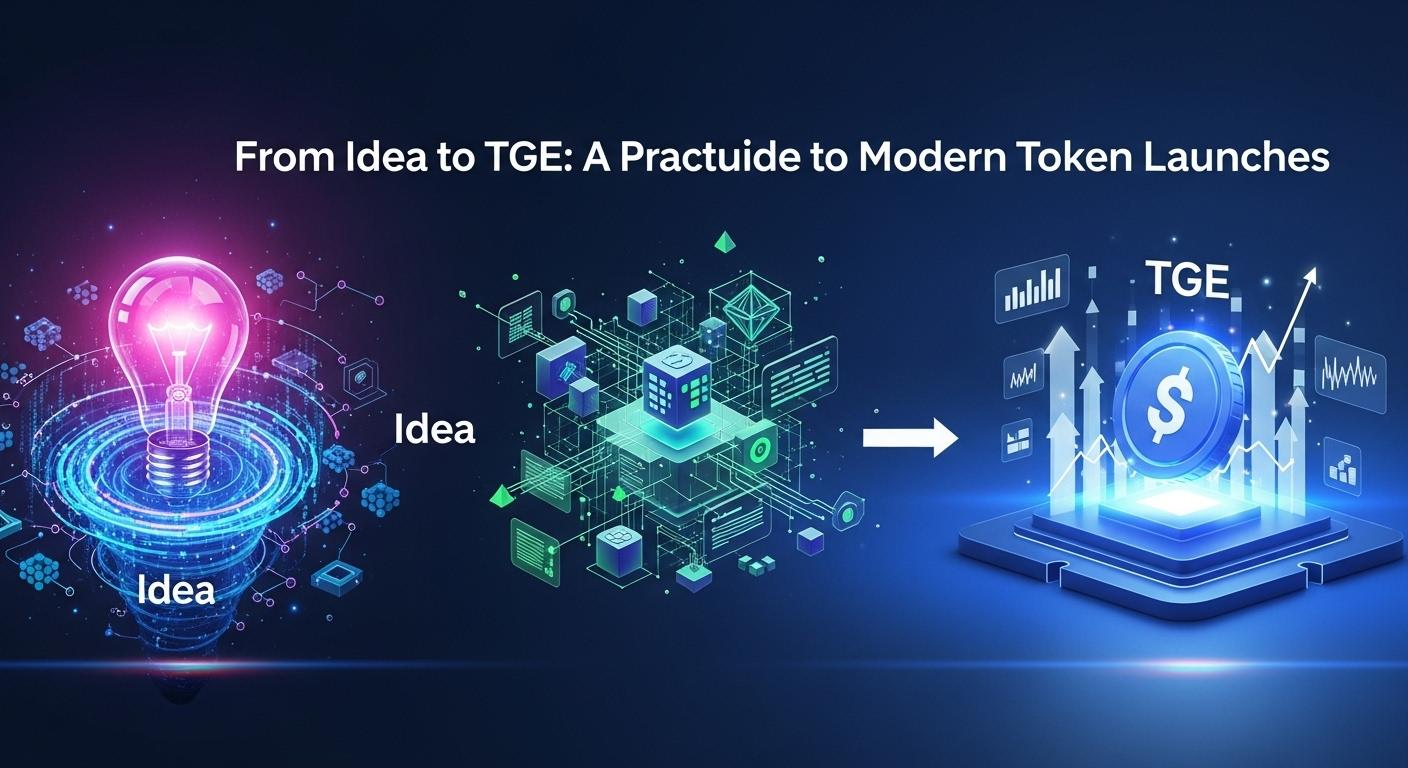From Idea to TGE: A Practical Guide to Modern Token Launches

Launching a token in 2025 involves far more than deploying a smart contract and announcing a sale. The landscape has matured, investor expectations have shifted, and regulatory oversight has tightened across every major jurisdiction. Projects need to demonstrate value early, articulate distribution mechanics clearly, show technical and compliance readiness, and build a credible story that aligns token utility with long-term ecosystem growth. Successful Token Generation Events (TGEs) today emerge from a disciplined product strategy, a verified tokenomics model, and a structured go-to-market plan—not hype alone.
This guide walks through the entire token launch lifecycle—from concept to TGE—explaining what founders must build, validate, and optimize at each step. By examining practical frameworks and real-world examples, the article clarifies how startups can move from initial idea to a strong market debut with confidence and clarity.
1. Understanding Why Token Launches Have Evolved
The market has changed dramatically since the ICO wave of 2017–2018. Retail investors are now more experienced, institutions occasionally participate, and compliance frameworks such as MiCA, SEC guidance, DFSA rules, and MAS licensing have pushed teams toward transparency and accountability. Meanwhile, on-chain data analytics and community evaluation tools have made it almost impossible to hide weak fundamentals.
The modern TGE reflects this maturity. Projects must demonstrate:
-
A validated real-world or digital ecosystem.
-
Clear token functionality backed by credible demand.
-
A strong token design that aligns incentives and avoids unsustainable economics.
-
Full regulatory clarity for the jurisdictions they target.
-
A phased roadmap showing long-term viability.
Moreover, competition has increased. With thousands of tokens already in circulation and dozens launching weekly, founders must articulate what differentiates their product and why their token deserves a place in the market.
A professional token development company can help you plan, build, and launch your token with a complete strategy from concept to TGE.
2. Moving from Raw Idea to a Validated Token Concept
The earliest stage of any token launch starts with shaping the concept into something realistic, market-ready, and long-term sustainable. Many founders understand the technical aspects but overlook the deeper strategic foundation.
Define the Core Problem and Value
A token should not exist merely because blockchain is trendy. A strong TGE begins with a genuine problem that the token addresses. For example:
-
Filecoin created incentivized distributed storage.
-
Chainlink solved off-chain data availability through oracle incentives.
-
StepN introduced a behavioral rewards layer to fitness through gamified emissions.
These tokens gained traction because they were tied to ecosystems with real need, not speculative demand.
Validate the Market
Market validation involves studying user behavior, competitor weaknesses, regulatory feasibility, and adoption potential. This also includes determining whether the token’s utility is compelling enough to drive consistent demand—an essential differentiator between short-lived hype and sustainable growth.
Structure the Ecosystem
Founders must outline roles, users, and incentive flows. Who earns? Who pays? Who stakes? Who receives rewards? Ecosystem clarity ensures that token demand persists once the initial hype fades.
3. Tokenomics: Designing Sustainable Value Instead of Hype
Tokenomics has become one of the most scrutinized aspects of modern token launches. Exchanges, VCs, analytics firms, and communities evaluate token distribution, supply mechanics, and utility long before a listing is approved.
Key Elements of Strong Tokenomics
1. Utility That Drives Real Usage
Tokens must serve actual purposes—access, payments, governance, staking, validation, or liquidity—not vague “ecosystem value.” When a token’s functionality connects deeply with product behavior, usage naturally drives demand.
2. Balanced Supply and Distribution
Unbalanced vesting schedules or excessive team allocation often lead to dumping risk. Modern best practices include:
-
Long-term vesting for insiders.
-
Moderate public sale ratios.
-
Reserve pools for liquidity and future emissions.
-
Transparent unlock schedules published publicly.
3. Incentive Alignment
Tokenomics should encourage behaviors that support ecosystem growth—staking for network security, rewards for early liquidity providers, or discounts for active users. Poorly aligned incentives can destroy a token economy quickly.
4. Deflationary or Controlled Emission Mechanisms
While some ecosystems require inflation to support validators or rewards, emissions must match ecosystem maturity. For example, Optimism’s seasonal emission cycles or AVAX’s capped supply model show how emissions can be structured thoughtfully.
4. Smart Contract Development and Security Foundations
From ERC-20 and BEP-20 to custom modules on Solana and Cosmos, the smart contract underpinning a token must be secure, auditable, and transparent. In 2025, security has become a non-negotiable pillar of successful TGEs.
Security Essentials Include:
-
Battle-tested contract standards instead of reinventing frameworks.
-
Strict access controls that manage minting, pausing, and treasury functions.
-
Zero hidden backdoors or admin privileges that could alarm investors.
-
Independent audits from reputable firms.
Historical exploits—from Nomad Bridge to Euler—have proven that even minor oversights can lead to catastrophic losses. A well-audited smart contract builds confidence early, strengthens exchange approvals, and supports investor trust.
5. Compliance and Legal Structuring for a Global Token Launch
As token launches globalize, compliance requirements grow more complex. A modern TGE must consider cross-border token sale regulations, anti-money laundering norms, and consumer protection laws.
Regulatory Considerations Include:
-
Whether the token is a utility token, governance token, or security token.
-
If the sale fits under Reg D, Reg S, or equivalent frameworks.
-
Licensing needs in regions like Singapore, UAE, Europe, UK, and USA.
-
KYC/AML processes for contributors.
-
Disclosure documentation such as whitepapers, risk statements, and legal opinions.
Not every token is a security, but treating regulatory clarity as a core process—not a formality—gives founders long-term stability and credibility with exchanges.
6. Building the Product Layer Before the TGE
One of the most decisive trends of the last three years is the shift toward product-first token launches. Projects with functioning prototypes or early user activity perform significantly better, both in sales and in post-TGE market momentum.
Key Product Milestones Before Launch:
-
MVP or testnet showing real utility.
-
Early community onboarding through waitlists, pilot groups, or early-access loops.
-
Metrics demonstrating usage patterns—even small ones.
-
Technical documentation and transparent development roadmap.
Investors today expect to see that the token is more than a pitch deck. A working product helps align narrative with reality.
7. Pre-TGE Marketing: Creating Visibility and Trust
Marketing success in modern token launches relies on trust, clarity, and evidence—not hype alone. Founders need sustained brand credibility built across community channels, education-driven campaigns, and narrative consistency.
Core Marketing Pillars
1. Narrative Positioning
This defines what makes your token essential. Good narratives are simple, relevant, and rooted in clear value. For example:
-
Celestia focused on modular blockchain infrastructure.
-
Arbitrum positioned itself around scaling liquidity and speeds.
-
TON’s revival narrative centered on Telegram’s user base.
A well-positioned narrative attracts long-term believers, not just short-term speculators.
2. Community Growth
Modern communities dislike artificial hype. Successful projects use:
-
Transparent progress updates
-
Real educational content
-
Ambassador programs
-
Interactive AMAs and quizzes
-
Developer insights and behind-the-scenes stories
Communities built on value—not giveaways—are the ones that survive market cycles.
3. Influencers and PR
Reputable influencers, thought leaders, and journalists significantly shape early perception. Partnerships should revolve around legitimacy rather than just impressions.
4. Launchpad, VC, and Exchange Engagement
Pre-TGE conversations with:
-
Early-stage crypto funds
-
Key opinion leaders
-
Launchpads (Polkastarter, Republic, ChainGPT Pad, etc.)
-
Tier-1 and Tier-2 exchanges
These stakeholders often guide pricing, token structure, and listing readiness.
8. Running the Token Sale: Models and Execution
A TGE’s success depends on choosing the right sale structure, managing demand, and maintaining transparency during allocation and distribution.
Common Sale Models
-
Private Sale for strategic investors
-
Presale / Community Sale for early supporters
-
IDO through launchpads
-
IGO/INO for gaming/NFT projects
-
Fair Launch with no private allocation
Each model carries different liquidity requirements, pricing strategies, and long-term implications.
Token Sale Execution Essentials
-
Clear contribution caps and allocation rules.
-
Real-time dashboards showing progress.
-
Documented vesting schedules.
-
Anti-bot and anti-sniping measures.
-
Open communication throughout the sale.
Projects that maintain transparency during this phase tend to build stronger post-TGE communities.
9. Liquidity, TGE Mechanics, and Initial Market Strategy
The exact moment of TGE—the token generation and listing phase—is where the groundwork either holds strong or falters. Poor execution here can undermine months of good preparation.
Key TGE Factors Include:
1. Liquidity Planning
Liquidity must match expected trading volume. Insufficient liquidity leads to volatile price swings, slippage, and poor price discovery.
2. Exchange Coordination
Tier-1 and Tier-2 exchanges often require:
-
Audit certificates
-
Legal opinions
-
Tokenomics documentation
-
Proof of liquidity reserves
-
Founding team KYC
Smooth coordination increases listing probability and strengthens market reception.
3. Treasury Controls
Treasury allocation, market maker agreements, and vesting enforcement ensure long-term price stability.
4. Market Maker Engagement
Professional market makers create smoother order books, reduce volatility, and protect the token during early trading.
10. Post-TGE: Sustaining Momentum Beyond the Hype
Many tokens lose traction after listing because teams fail to sustain momentum. A strong post-TGE strategy maintains growth, utility adoption, and market stability.
Post-TGE Priorities
1. Product Iteration
Continuous shipping of new features, new integrations, or expanded functionality validates the token’s long-term purpose.
2. Real Utility Activation
Token use cases should go live quickly:
-
Staking
-
Governance voting
-
Payments
-
Access layers
-
In-app rewards
Delaying utility can cause early-market fatigue.
3. Market Expansion
Strategic partnerships, cross-chain integrations, and ecosystem collaborations build legitimacy.
4. Continuous Reporting
Quarterly updates, treasury reports, and open governance enhance transparency and long-term trust.
5. Community Retention
Engagement programs, reward cycles, and educational content ensure that community interest doesn’t fade once the price stabilizes.
Conclusion
A successful token launch in 2025 is the outcome of disciplined planning, not viral hype. The strongest TGEs today combine:
-
A validated product vision.
-
Tokenomics rooted in sustainable value.
-
Strong security and compliance foundations.
-
Thoughtful community and marketing strategy.
-
Transparent and structured TGE execution.
-
A long-term roadmap backed by real utility.
The transition from idea to TGE represents a full business cycle—product development, financial design, community building, legal structuring, and market strategy. When executed with precision and integrity, a token launch can unlock a thriving ecosystem that grows far beyond its initial sale.
Projects that treat the TGE as the beginning—not the end—are the ones that stand out in today’s competitive and fast-evolving crypto environment.
- Art
- Causes
- Best Offers
- Crafts
- Dance
- Drinks
- Film
- Fitness
- Food
- Spellen
- Festival
- Gardening
- Health
- Home
- Literature
- Music
- Networking
- Other
- Party
- Religion
- Shopping
- Sports
- Theater
- Wellness



